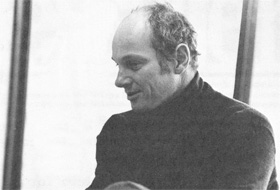Dr. Jim Cronin: Profile of a Man in Motion

Dr. Jim Cronin
Dr. Jim Cronin put in a full day on Friday, January 14. He spent the morning in Washington, D.C. at the ceremony at which the Energy Research and Development Administration awarded its 1976 E. 0. Lawrence awards "to men and women who are not more than 45 years old... and who have made especially meritorious contributions to the development, use or control of atomic energy in all relevant sciences..."
By early afternoon he had returned to Illinois to attend an open meeting at Fermilab on the new colliding beam group which he will head, on a part time basis. He will also continue to work as an experimenter in the Proton Area, commuting from the University of Chicago where he is a professor of physics.
Dr. Cronin was born in Chicago, Illinois. He did his undergraduate study at Southern Methodist University, then attended the University of Chicago as a National Science Foundation fellow, receiving his M.S. in 1953 and a Ph.D. in 1955. He has served on the staffs of the Brookhaven National Laboratory, Princeton University, and the University of Chicago. His major research has been in the area of high energy physics where he has played a major role in exploring the basic symmetries of nature.
In 1964, Cronin, in collaboration with James Christenson, Val Fitch and Rene Turlay, conducted an experiment at the Brookhaven National Laboratory in New York which contradicted the almost universally-held belief of physicists that natural laws of physics remain unaltered in an anti-matter universe where everything is mirror-reflected and electrical charge is reversed. The experimenters' findings are considered a landmark in the study of the forces at work in the sub-atomic world of matter and anti-matter.
Since the early beginnings of the Fermilab accelerator, Cronin, with collaborators from the University of Chicago and Princeton University, have been measuring the production of particles at very high energies and large angles in Proton east. These large transverse momentum (violent) collisions are presumed to be sensitive to the internal structure of the proton. It is our hope to demonstrate that the knowledge of the proton structure, so beautifully evidenced by electron and muon scattering experiments at SLAC and FNAL can lead to understanding of the more complicated collision of one proton with another.
Much of what we have learned concerning the production of high transverse momentum hadrons and muons, and high transverse momentum pairs can be understood in terms of the proton structure. These experiments and others at FNAL are beginning to answer another question, namely; what are the forces and interactions between the constituents of the proton?
The Colliding Beams Experiments Department has been set up within the Fermilab Research Division. Cronin will serve as Department Head with Dr. James Walker as Associate Head. The Department is to be a focus for a number of activities directed toward planning for the exploitation of proton and anti-proton colliding beams in the Main Ring tunnel. The Department will be responsible for establishing the scope of the Main Ring experimental enclosures, their design specifications, and construction of the experimental facilities.
"To me the creativity lies in the work of bringing about the collisions of the two beams. Once the colliding beams are achieved it is not so difficult to conceive of how to carry out the experiments. I have always carried out physics experiments in the neat situation where the particle beam is supplied. For once in my life I would like to have the pleasure of participating in and hopefully contributing to the achievement of the situation that makes the experiments possible. My job will be mostly organizational since all the resources and talent exist at Fermilab to carry out this work. I agree with Bob Wilson who says, "If we physicists are sufficiently clever and manage to implement the colliding beams, then the physics that will result just boggles the mind."


